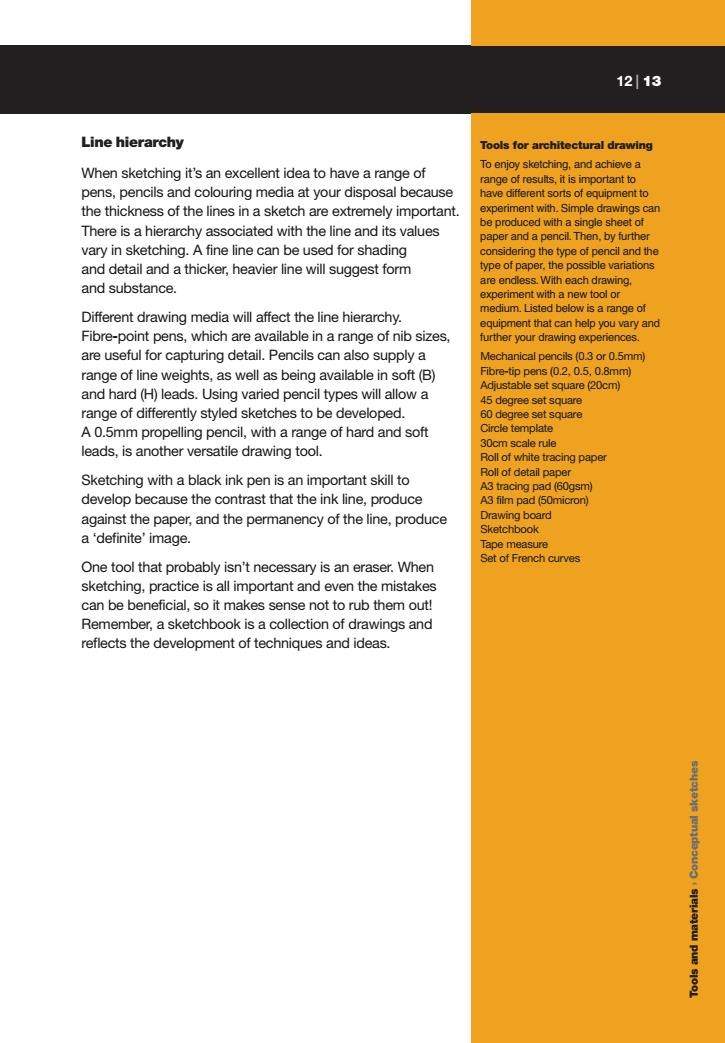正在加载图片...

12|13 Line hierarchy Tools for architectural drawing To enjoy sketching,and achieve a When sketching it's an excellent idea to have a range of range of results,it is important to pens,pencils and colouring media at your disposal because have different sorts of equipment to the thickness of the lines in a sketch are extremely important experiment with.Simple drawings can There is a hierarchy associated with the line and its values be produced with a single sheet of paper and a pencil Then.by further vary in sketching.A fine line can be used for shading considering the type of pencil and the and detail and a thicker,heavier line will suggest form ype of paper,the possible variations and substance. are endless.With each drawing. experiment with a new tool or Different drawing media will affect the line hierarchy. medium.Listed below is a range of equipment that can help you vary and Fibre-point pens,which are available in a range of nib sizes, further your drawing experiences. are useful for capturing detail.Pencils can also supply a Mechanical pencils(0.3 or 0.5mm) range of line weights,as well as being available in soft(B) Fibre-tip pens(0.2,0.5,0.8mm) Adjustable set square(20cm) and hard (H)leads.Using varied pencil types will allow a 45 degree set square range of differently styled sketches to be developed. 60 degree set square A 0.5mm propelling pencil,with a range of hard and soft Circie template 30cm scale rule leads,is another versatile drawing tool. Roll of white tracing paper Roll of detail paper Sketching with a black ink pen is an important skill to A3 tracing pad(60gsm) develop because the contrast that the ink line,produce A3 film pad(50micron) against the paper,and the permanency of the line,produce Drawing board Sketchbook a'definite'image. Tape measure Set of French curves One tool that probably isn't necessary is an eraser.When sketching,practice is all important and even the mistakes can be beneficial,so it makes sense not to rub them out! Remember,a sketchbook is a collection of drawings and reflects the development of techniques and ideas.C M Y K T Cheryl Basic Architecture Upon approval Please sign: Name and Date: 001-033 chapter 1cw (7).qxd 8/15/07 2:30 PM Page 13 12 | 13 Tools for architectural drawing To enjoy sketching, and achieve a range of results, it is important to have different sorts of equipment to experiment with. Simple drawings can be produced with a single sheet of paper and a pencil.Then, by further considering the type of pencil and the type of paper, the possible variations are endless. With each drawing, experiment with a new tool or medium. Listed below is a range of equipment that can help you vary and further your drawing experiences. Mechanical pencils (0.3 or 0.5mm) Fibre-tip pens (0.2, 0.5, 0.8mm) Adjustable set square (20cm) 45 degree set square 60 degree set square Circle template 30cm scale rule Roll of white tracing paper Roll of detail paper A3 tracing pad (60gsm) A3 film pad (50micron) Drawing board Sketchbook Tape measure Set of French curves Tools and materials › Conceptual sketches Line hierarchy When sketching it’s an excellent idea to have a range of pens, pencils and colouring media at your disposal because the thickness of the lines in a sketch are extremely important. There is a hierarchy associated with the line and its values vary in sketching. A fine line can be used for shading and detail and a thicker, heavier line will suggest form and substance. Different drawing media will affect the line hierarchy. Fibre-point pens, which are available in a range of nib sizes, are useful for capturing detail. Pencils can also supply a range of line weights, as well as being available in soft (B) and hard (H) leads. Using varied pencil types will allow a range of differently styled sketches to be developed. A 0.5mm propelling pencil, with a range of hard and soft leads, is another versatile drawing tool. Sketching with a black ink pen is an important skill to develop because the contrast that the ink line, produce against the paper, and the permanency of the line, produce a ‘definite’ image. One tool that probably isn’t necessary is an eraser. When sketching, practice is all important and even the mistakes can be beneficial, so it makes sense not to rub them out! Remember, a sketchbook is a collection of drawings and reflects the development of techniques and ideas. 001-033_R+T_1stp_SN.qxd 10/11/07 1:45 PM Page 13